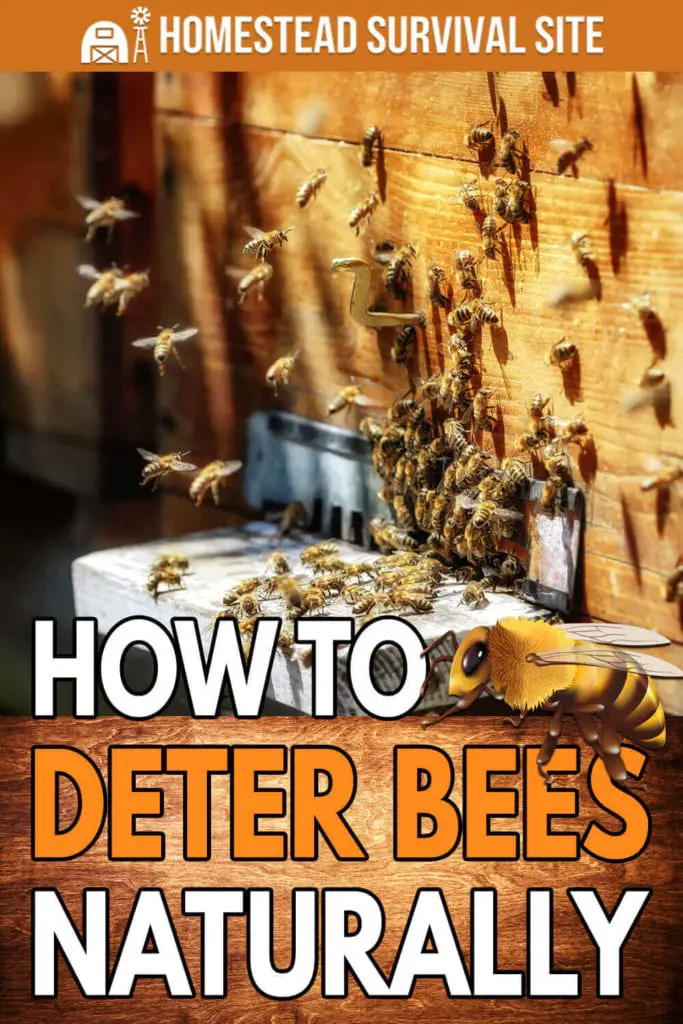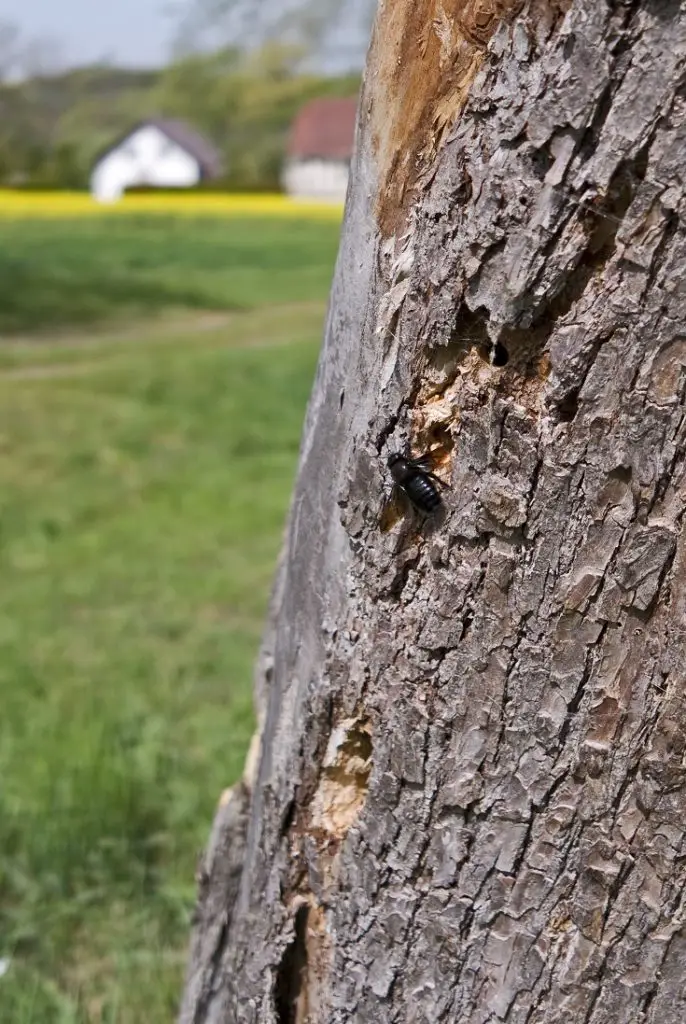[ad_1]
Estimated reading time: 8 minutes

Bees are a wonderful thing to have on your homestead, as long as they are the right kind. Honeybees and Mason bees will help your garden grow, but bees like Carpenters can create a lot of headaches and damage to your property.
When you include members of the wasp family under the general “bee” umbrella of small flying bugs (as many folks do) there are a whole host of pesky insects that homesteaders do not want taking up residence on their land. In addition to carpenter bees, some of the most dreaded flying and stinging insects often deemed a nuisance include: yellow jackets, hornets, paper wasps, and mud daubers.
Sometimes even the wondrous and food-chain-necessary honeybee can be deemed a nuisance. Although you definitely want honey bees around your garden, in your apothecary patch, and pollinating edible and ornamental plants of all types, that does not mean you want a hive buzzing right by the front door …. Or worse yet, the bees taking up residence in the barn or inside of the home’s walls.
Getting rid of nuisance bees without hurting the growing environment or your wanted honeybees, as well as relocating honey bees without causing harm, is entirely possible. Caustic chemical sprays are entirely unnecessary to rid yourself of nuisance bees.
What Are Carpenter Bees?
Carpenter bees are often mistaken for very large bumblebees. Carpenter bees are often commonly referred to as “wood boring bees” or just “boring bees.” These nuisance bees are typically found hovering around a home, barn, or other wooden structures. They build nests by burrowing into the wood and destroying it.
Wood-boring bees are generally considered to have an aggressive demeanor, especially during their mating season. They will do a flyby of humans to warn them away from their nests in great urgency. Thankfully, the aggressive carpenter bee rarely ever stings humans—even during nest removals.
When Is The Best Time To Get Rid Of Nuisance Bees?
Carpenter Bees
Wood boring bees live for roughly one year, with the next generation being hatched during the late weeks of summer. Expect new carpenter bees to begin emerging from their nests in late August or September. Removing the nest and destroying it or chasing off the carpenter bees before they have the chance to hatch a new brood is ideal.
Any adult carpenter bees that survive the winter will die come July. It is during the late spring when most folks start noticing a carpenter bee infestation after they come out of the nest and start flying around wood porch posts, barns, and plant themselves around any other wood boards, beams, and posts that comprise house frames, porches, decks, shelter houses, swing sets, etc.

It is the male bees that you will likely find to be the largest nuisance. They tend to be the most aggressive and will fly not only around people nearing “their” territory but male boring bees do not possess the ability to sting. Female carpenter bees can sting and also be aggressive, but rarely ever exercise their pain-inducing capabilities.
Bumblebees
Bumblebees can also be a nuisance around the homestead and are often mistaken for carpenter bees. Bumblebees are more social than the rather solitary carpenter bees and boast a hairy abdomen. But, these stinging insects do offer pollination for your crops, plants, and herbs. Relocating them away from an area where they have become a nuisance and redirecting them back towards a growing area might be advantageous.
However, if their hive is located too close to the growing plot, get into the ceiling or walls of your home, or you have a loved one with a bee allergy, ridding them from your homestead entirely may be necessary.
All bumblebee workers typically die before October, so it is unlikely you will encounter any of these potentially nuisance bees during the fall and winter months. If you are having an issue with bumblebees, it is imperative you deal with it before they become more difficult to locate and start preparing for a new spring brood.
Bumblebees are typically far more active during their “flight period” in the morning to afternoon hours. During the hot months of the years bumblebees will most likely be encountered during the cooler pre-dusk or morning hours.
Like honeybees, removing a bumblebee nest should occur after dusk once all of the colony members have come back home for the night. If the bees are in your ceiling or your walls you can try using some of the non-lethal tips to rid your home of them outlined below, but it is most likely that calling in a professional beekeeper or pest removal service will be needed for such an intricate infestation.
Masonry Bees
While Masonry bees (or mason bees as they are often dubbed) do not typically cause severe damage to structures like carpenters bees can, they still excavate or even enlarge existing holes.
Female mason bees often not only revisit but re-use their brooding nest. If you destroy or remove a mason bee nesting area, it is likely they will not come back to the spot, eliminating the pollination they would have provided to your plants. Only touch or otherwise work in the area where you find a natural mason bee nest if you consider this pollinator variety to be a nuisance bee you want to remove.
Masonry bees are attracted to soft bricks and holes in mortar joints. Something as simple as removing brick piles from an area and repairing mortar can deter these non-aggressive and solitary bees from a location where they are not wanted.
You can also make or buy a mason bee house to attract these potent little pollinators to a space on your homestead where they can be useful instead of being a slightly destructive nuisance.
How To Get Rid Of Nuisance Bees Naturally
1. Peppermint
Spray peppermint essential oil around an area where bees are a problem.
2. Citrus
Spray citrus essential oil or the liquid from boiled citrus fruit and skins to deter bees from a hive or area.
3. Distilled White Vinegar
Mix at a 50/50 ratio with water and spray around areas you want nuisance bees to steer clear of.
4. Cinnamon
Sprinkle the spice around where the hive is located or where the bees hover daily in the late afternoon or evening hours. It will probably take a week or so, but the bees usually take the hint and leave the area.
5. Finish Wood
Carpenter bees almost always prefer to bore into untreated or unfinished wood, including barn wood that has lost its protective coating over the years. Use treated wood and/or paint, varnish, or clear coat exposed wood on dwellings and structures to deter carpenter bees from choosing the spot to make a home.
6. Smoke
As you are likely noticing from this list of natural and non-lethal ways to get rid of bees, these insects have a heightened sense of smell. Therefore, using smoke to expel them from your homestead or a portion of your homestead is yet another simple and nearly free way to get rid of nuisance bees.
Once they smell the smoke (which will not take long) growing beneath their hive or adjacent to their living area, they will often vacate the area. Starting a campfire safely near a hive or infestation area often agitates carpenter and masonry bees, so be prepared (and dressed for) dealing with a lot of aggressive and angry bees at once.
7. Citronella
Burning a citronella candle or squirting this same scent of essential oil works equally well with both bees and mosquitoes. Burning the candles for a few hours or repeated spraying of citronella essential oil in the spot you want the nuisance bees to leave should do the trick in just a couple of days.
8. Garlic
Sprinkle garlic around the area you want the bees to leave. Or you can mix crushed cloves with enough water to make a spray and squirt it around the hive or frequented area for a few days to a week to get rid of the nuisance bees.
9. Tea Tree Oil
Squirt or sprinkle droplets of this potent and rather stinky oil around the area you want the bees to vacate and within a matter of a few days to a week they should be gone.
10. Cedar Oil
Bees (and most other insects) loathe the smell of cedar oil. Spraying it around their hive, nest, or frequented area should coax them to leave in a matter of days.
11. Moth Balls
The stink of the mothballs will definitely run bees out of a hive or a specific area where they are placed. You must be especially careful when using mothballs because they are toxic if licked or consumed by pets, livestock, and little humans who are left unattended in their presence.
12. Eucalyptus Oil
While bees are attracted to sweet smells, like those of fruit and flowers, they tend to extremely dislike the smell of eucalyptus essential oil. You can squirt the oil alone around a problem infestation or hive area, or combine it in a squirt bottle with peppermint and citrus oil for even more potent results.
Removing nuisance bees naturally and without killing them will take a bit more patience than simply spraying a chemical or even organic insecticide (which can kill ‘good bugs’ you want to keep around the house and garden) but the humane and less environmentally disruptive scenario created by using one of the 12 tips above should yield excellent results.
Up Next:
[ad_2]
Source link
Get more stuff like this
in your inbox
Don't Be Left Unprepared
Thank you for subscribing.
Something went wrong.




